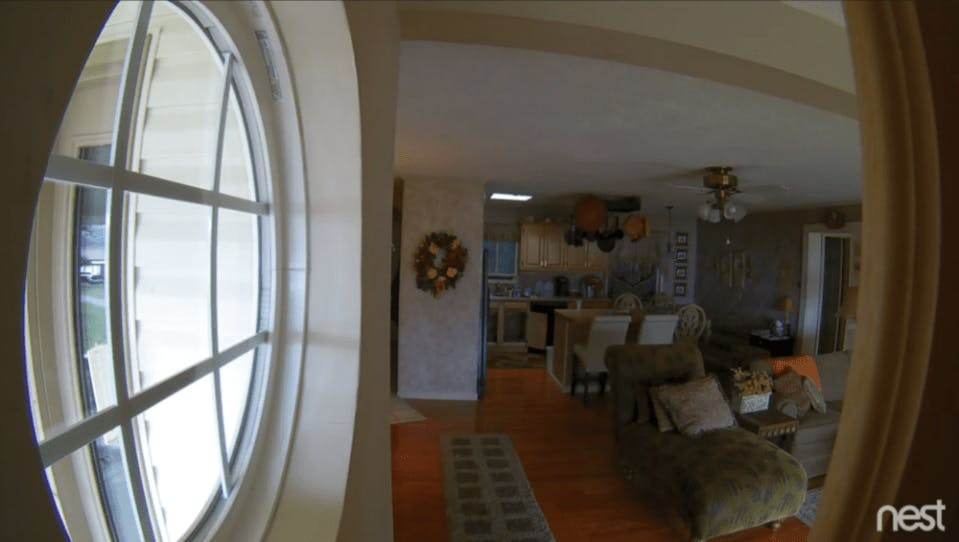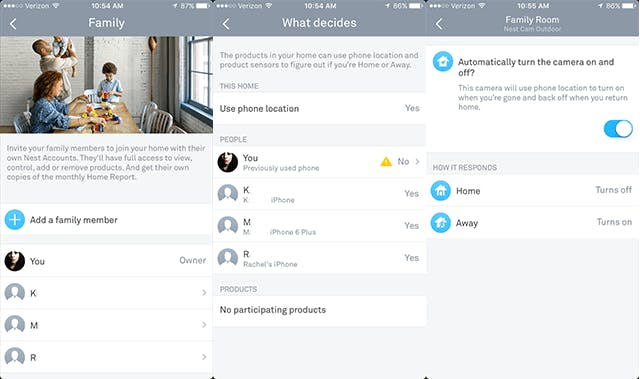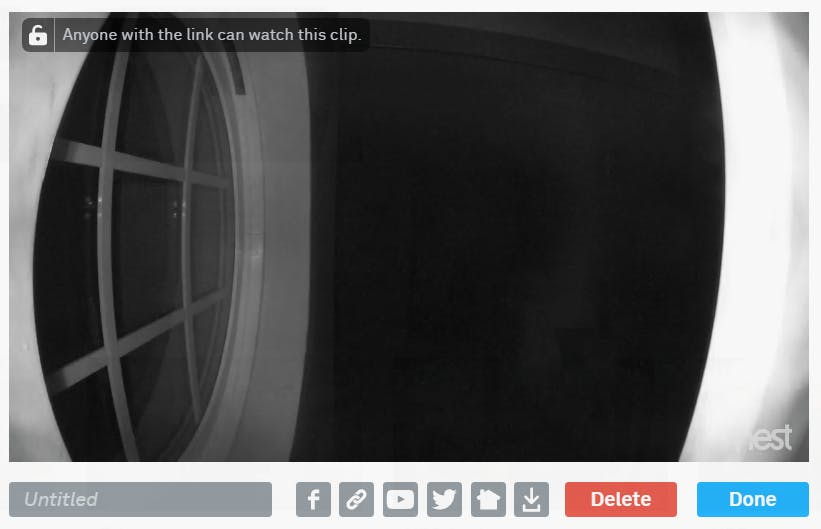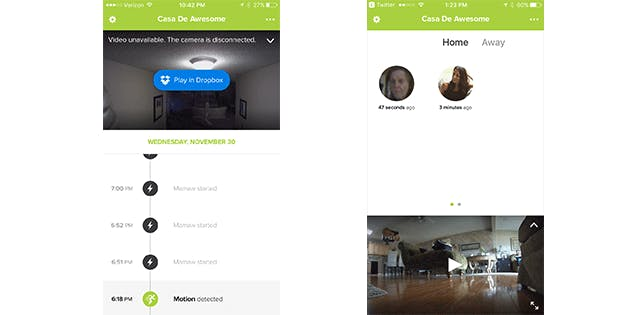Low Cost Tech Solutions for Aging Loved Ones
Before you invest your time into reading this article, you should know one thing: All of the solutions below require an internet connection. If you want a mission critical device, you should look into a cellular monitoring system as offered through traditional medical alert companies.
| Device: | Type: | When to use: | |
|---|---|---|---|
| Nest Cam | Camera | When you want 24/7 video history and two-way audio. | Buy Here |
| Netatmo Welcome | Camera | When you want to know if your loved one made it out of bed in the morning. | Buy Here |
| Amazon Echo + Connect | Smart Home Assistant | When you want to use hands-free calling and access to 911. | Buy Here |
| Amazon Show and Spot | Smart Home Assistant with a Camera | When you want to be able to see and talk to your loved one or even drop-in on them. | Buy Here |
| Google Home | Smart Home Assistant | When you want to use hands-free calling. | Buy Here |
| VTECH CareLine | Home Phone | When you want an affordable medical alert device. | Buy Here |
| SmartThings | Smart Home Hub | When you want to track your loved one’s movements using sensors. | Buy Here |
Nest Cam
One possible solution, especially for seniors who have a medical condition or are prone to falling down, is a smart camera. Of course, you need to get your loved one's permission to add a camera to their home that you can monitor.
One of the best smart cameras out there for this specific purpose is Nest Cam.
PROS:
1. FHD Video

One of Nest Cam's shortcomings as a home security camera is a positive when it comes to monitoring aging loved ones. Nest doesn’t send a notification for every event. Instead, it sends one alert about every 15 minutes. So if your loved one decides to take a stroll around the house, you’ll receive fewer alerts than you would using a camera that sends an alert for every little movement.
With a Nest Aware Subscription, you will also have access to Activity Zones. Activity Zones will help reduce the number of alerts you receive by monitoring areas you care about while ignoring the rest. For example, if the senior loves to sit and watch movies, you can choose not to monitor the couch.
3. 24/7 Recording w/ Timelapse
Unfortunately, no security camera is 100% reliable, making access to recorded video history crucial. As Nest is always recording (if you pay for Nest Aware starting at $5/month), you can go back and check on your loved ones on-demand. Plus, Nest has features built into the web and mobile app that make scrolling through footage easy, like Timelapse, allowing you to sort through an entire week’s worth of footage in minutes.
4. Two-Way Audio
Two-way audio was another non-negotiable feature. You can use it to talk to your loved one or communicate with caregivers when they're present. Using two-way audio, you can use your phone and the camera like a walkie-talkie. And though many security cameras boast two-way audio, Nest’s version of the feature is actually usable.
Tip for Two-Way Audio: While you can adjust the microphone’s sensitivity, you cannot adjust the speaker volume. You will need to place the camera somewhere where your loved one or their caregiver will be able to hear it.
5. Indoor Cameras, Outdoor Cameras, Smart Thermostats, IFTTT
Finally, you can expand Nest Cam’s ability to protect by adding other indoor cameras, the outdoor Nest Cam, or other Nest devices like the Nest Thermostat. You can even create rules between the camera and other smart home devices using IFTTT.
CONS:
Of course, there is no perfect solution, and there are definitely cons to using Nest as a means to watch over seniors.
1. Family Access Not Customizable

Nest offers family access, meaning that multiple users can watch over your loved one, but there’s a catch. Family access through the Nest app is one size fits all. There is no master account; all users are created equal, and all users must have the same settings.
This is a problem if you have a Nest Cam in your own home in addition to the one you put in your loved one's house. If you share your account to family members so they can pitch in in monitoring your aging loved one, giving them access to the senior's Nest Cam will also give them access to your Nest Cam. That's a huge breach to your privacy.
One possible solution is to set up a separate Nest account that you can share with your family members. Then, create a schedule where you all take turns monitoring the account. For example, family A monitors the account on Mondays and Tuesdays, family B on Wednesdays and Thursdays, and family C on the weekend. Because you can only log into one Nest account at a time, you should make an arrangement with your spouse or children as to who will monitor your Nest Cameras whenever it's your turn monitoring the senior's camera.
2. Paid Plan Recommended
If you are using Nest to monitor an aging loved one, you can’t do it without Nest Aware. Unfortunately, all of the useful features will cost you.
| Without Nest Aware | With Nest Aware | |
|---|---|---|
| Motion Detection | Basic | Intelligent |
| Live Streaming: | ||
| Video History: | 3 Hour Snapshots | 5, 10, or 30 Days Video History |
| Continuous Video Recording: | ||
| Two-Way Talk: | ||
| Zoom 8x: | Yes, 12x for Nest Cam IQ | Yes, 12x for Nest Cam IQ |
| Person Alerts: | Nest Cam IQ and Nest Hello Only | |
| Familiar Face Alerts | Nest Cam IQ and Nest Hello Only | |
| Supersight Tracking | Nest IQ Only | Nest IQ Only |
| Activity Zones: | ||
| Create Clips and Timelapses: | ||
| Share Live Streams: | ||
| Geofencing | ||
| Sound Detection | Basic | Intelligent |
| Dog Barking/Person Speaking Alerts |
3. Some Issues With Dark/Light Contrast

Another con to using Nest Aware is that we had some issues due to the placement of the camera. At night, the light from the porch created a contrast that made it tough to see into the kitchen. We eventually rectified this by leaving a lamp on at night.
4. Internet Reliant
5. Loss of Privacy
Having people watch over you 24/7 is evasive, so you must make sure to get your loved one's permission.You must also ensure them that you're doing it not to spy on them but for their own well-being.
Netatmo

Like Nest Cam, Netatmo is a home security camera. However, it can’t record 24/7. Instead, it records based on event. What makes it unique is that it offers facial recognition.
PROS:
1. Facial Recognition

Though not perfect, Netatmo is fairly efficient at recognizing people. This feature allows the camera to provide a unique value when monitoring seniors. While the camera can detect motion, detecting your loved one’s face is much more accurate.
In addition to known faces, you can receive alerts for unknown faces. Alerts are customizable, and you can choose to receive alerts always or only if no one is home. And while you can’t setup an alert to let you know if Welcome hasn’t seen your loved one in awhile, you can work around this limitation via the “Welcome Home” feature.
Welcome Home lets you know when a recognized face is home. You can use this to your advantage through the creation of rules. First, you will need to set an away time period. For example, you could say, consider grandma away if you haven’t seen her for 5 hours. Then, using an IFTTT applet, you can create a rule that says, “Call me when grandma arrives home.” When your loved one is asleep, it will consider her away. When she walks through her bedroom door in the morning and is spotted by the camera, she will be marked as home, and you will be alerted. You can also setup arrival push notifications directly within the Netatmo Home app.
To help reduce the burden of notifications, you can set smart notifications that will group multiple notifications into one.
2. FHD Video
3. Free Cloud Storage
Unlike Nest Cam, Netatmo Welcome offers free cloud storage. Instead of limiting cloud to a certain amount of time, Netatmo limits you to a certain amount of space. The camera supports a microSD card, and videos are also available through Dropbox where you will have access to 5GB of free storage. You can also send videos to your personal FTP server.
4. Outdoor Camera, Tags, Security Siren, Smart Smoke, and IFTTT
Like Nest Cam, Welcome doesn’t have to work alone. You can add an outdoor camera, smart thermostat, tags to monitor windows, doors, and cabinets, or you can even connect to other smart home devices via IFTTT.
CONS:
1. Connection Issues and Customer Service
Netatmo is known to have connection issues and unfortunately, troubleshooting it isn't as simple as troubleshooting other cameras. Even worse, Netatmo’s customer service is seriously lacking.
If you need support, you will find that you can’t get it without a serial number. And when I say that, I mean it literally. You can’t even bypass the online form without it, and Netatmo lacks phone support. The coveted serial number is located on the back of the original packaging. If you’ve thrown the box away like a normal person, it will be virtually impossible for you to reach someone. And no, you can’t make up a fake serial number, we tried.
When faced with connection issues when we tested Netatmo, it took three weeks for us to get a response from Netatmo support and via Twitter (@NetatmoSupport) no less. Even after connecting with support, we had to do things that would be difficult for most seniors to do on their own, including moving the camera to a location where it had a direct Ethernet connection and providing the MAC address. They had us to do things like:
- Open ports UDP 4500 + 500
- Enable IPsec
- Try changing the DNS server with those of Google (main: 8.8.8.8 / secondary: 8.8.4.4)
- Give a static IP address to the camera using the MAC address.
2. Internet Reliant
3. Loss of Privacy
Amazon Echo, Dot, Show, and Spot
Amazon Echo is a smart speaker that provides security features through the use of skills. What makes it useful for watching over an aging loved one is that you can use the device to make hands-free emergency phone calls. If you want more details, we have an article about using Alexa for voice calls here.
Dot is a cheaper version of Echo with a weaker speaker, but it can still make voice calls.
Show and Spot offer the same features as Amazon Echo and Dot. As listening devices, you can use your voice to make calls in an emergency. The difference between these two devices and Echo/Dot is that Show and Spot have a screen. In addition to making voice calls, you can use them to make video calls.
All of the devices support voice ID to make calling more intelligent. Voice ID is essentially voice recognition. If the device recognizes your voice, it will call your contacts. For example, “call mom” will call your mom.
Finally, if you register your phone number within the Alexa app, it will also have a caller-ID feature.
PROS:
1. Hands-Free Calling
There are multiple ways to enable calls. The easiest way is to use Alexa Calling or Skype. Alexa Calling is a free feature that allows you to make phone calls to most phone numbers in the US, Mexico, and Canada. You can also call by contact name or you can call to other Alexa devices including the Alexa app. Skype is also free to activate, but some features require a premium Skype account. For free, you can call (or video call if you have Echo Show or Spot) your Skype contacts or receive Skype calls. If you have a premium Skype account, you can also make calls to mobile and landline numbers from all over the world using your available call minutes.
Recently, Amazon added hands-free texting. Using this feature, you can send messages to other Alexa users. If someone sends you a message, you’ll get a notification and hear an audio tone from your Alexa device. Alexa can also play your messages. It’s a great feature for communication, but it’s not recommended for emergency situations. Unlike Alexa Calling, Alexa Messaging’s audio tone is easy to miss.
In my opinion, the three best options for hands free calling in an emergency situation are either the Echo Connect, SafeTrek, or a skill called Ask My Buddy. Ask My Buddy works with both Amazon Echo and Google Home. Echo Connect is a $34.99 device that works with all Echos (Dot, Plus, Spot, Show, etc.) but requires that you have a landline or VoIP service. The major benefit of adding Echo Connect is that your loved one can use it to call 911 using only their voice. SafeTrek is a personal safety app. For $2.99 per month, they provide access to an emergency monitoring center. If your loved one asks Alexa for help, Alexa will tell SafeTrek, and SafeTrek will call for assistance.
2. Hands Free Connection to Multiple Contacts
While only Echo Connect will allow your loved one to call 911, there is one feature that sets Ask My Buddy apart from Alexa Calling: multiple contacts. Ask My Buddy allows your loved one to reach out to multiple emergency contacts using their voice where Alexa Calling, including Echo Connect, can only contact one person at a time.
Ask My Buddy can contact multiple emergency contacts multiple ways: email, text, and phone call. For free, Ask My Buddy will support up to five emergency contacts. Your loved one can dial one person, or she can contact everyone at once.
2. Video Calls and Drop-Ins (Show and Spot Only)
In order to make a video call to Show or Spot, you will also need a Show or a Spot or you can make video calls by downloading the free Alexa app. In addition to video calls, you can use Drop-Ins. If you are worried about your loved one, you can literally drop in via the device. When you make a call to your loved one’s device, it doesn’t matter if they answer or not; you will be able to peak in on them to make sure all is well.
CONS:
1. Must Remember the Trigger Phrase
The downside to using Ask My Buddy and SafeTrek is that Alexa isn’t always forgiving when you don’t speak the correct phrase. For example, say, “Alexa, Ask My Buddy to call John Doe,” and Alexa will tell you that you don’t have a contact named “Call John Doe.” The correct phrase is, “Alexa, Ask My Buddy To Alert John Doe.” One word can make a difference, and in an emergency situation, it might be hard to remember to say the phrase word-for-word.
Alexa Calling and Skype do not suffer from the same problem as you can dial by phone number or contact name. You can simply say, “Alexa, call (contact name/phone number).”
2. Must Be Within Shouting Distance
A second downside to using an Alexa-enabled device is that you must be within shouting distance. For example, what if your loved one falls in the shower? Are you willing to place a listening device in their bathroom?
3. Internet Reliant
4. Free Account is Limited to 10 Messages Per Month
This con applies to Ask My Buddy only. The free version of the service is limited to 10 messages per month.
Google Home
Like the Amazon Echo, Google Home is a listening device that can place hands-free emergency calls. However, they approach the task differently.
PROS:
1. Free Calls To Any U.S. or Canadian Number
Google Home can place outgoing calls to any U.S. or Canadian phone number for free. Using this feature, you can call your phone contacts (requires that your contacts are linked to Google Assistant) just by saying, “Hey, Google. Call Jane Doe.” Using this feature you can even call by phone number or call businesses and establishments. For example, you can say “Hey, Google. Call {hospital name}.” Google Home will Google search the establishment and call the listed number.
2. Shortcuts
The same Ask My Buddy service that works with Alexa also works with Google Home. Unlike Alexa, you don’t have to memorize a predefined phrase. Instead, you can choose a phrase or phrases you’re comfortable saying and memorizing.
Creating shortcuts, done through the Google Home App, is just like creating rules. First, define your phrase or phrases like “help me” or “call for help” and then assign those phrases an action like triggering Ask My Buddy. You can assign the same action to multiple phrases to make it easier for your loved one to remember what to say.
CONS:
1. Internet Reliant
2. Must Be Within Shouting Distance
3. Can’t Receive Incoming Calls
4. Voice Recognition
This is one use case where Google Home’s beloved voice recognition feature might be more of a hindrance than a help. If you want your Shortcuts to work for multiple users, you will have to create the same Shortcuts on every user’s app.
VTECH SN6187 CareLine Caller ID
Of all the solutions discussed, VTECH CareLine is the solution that most resembles a medical alert device. It uses your existing phone service combined with a wearable pendant to protect your loved one.
PROS:
1. Wearable Pendant
You never know where your loved one might be when they need help. They might be outside of your security camera’s range or outside of Alexa’s hearing distance, but if they are wearing a pendant, they are always protected. VTECH’s wearable device is a little larger than a key fob and can be worn at all times.
2. Speed-Dial 9-1-1
Where most of the other smart home devices rely on you to protect your loved one, VTECH CareLine connects your loved one to 911 directly. The wearable pendant includes two programmable speed-dial buttons. You can program one button to call 911 and the other to call you.
CONS:
1. Internet and Phone Service Reliant
2. Requires Loved One To Wear Pendent
SmartThings

A final option is to take a self-monitored home security system and flip it around. Instead of monitoring for someone you don’t want around, you are monitoring for someone you do want around.
Self-monitored security systems work through sensors. They have sensors for motion, doors, windows, floods, smoke, CO, glass break, temperature, and more. To monitor an aging loved one you will need to purchase door/window sensors, motion sensors, and a hub. As using sensors to monitor aging loved ones is a bit of a creative task, we recommend the SmartThings hub.
PROS:
1. Option for Security Camera
In addition to sensors, SmartThings works with security cameras. It works with Arlo Wire-Free, Ring Video Doorbell, Samsung SmartCam, and the Skybell HD. The downside to all of these cameras is that they lack continuous video recording. The upside is that you can create rules between your cameras and your sensors. For example, if the front door opens, you can have your Arlo camera automatically trigger a recording.
2. Battery Backup
A second benefit to using a SmartThings hub is that it has some built-in redundancy. For one, it includes battery backup. Two, if the internet goes down, some rules will still run locally.
3. Monitor Bedroom Doors and Motion
Sensors can sometimes provide just as much data as a camera without compromising personal privacy. They can tell you if your grandmother’s up walking around, which room she’s in, and more. For example, you can create a rule that says, “Let me know if there is NO movement or let me know if the door doesn’t open by 9 am.” Or perhaps even, “let me know if the medicine cabinet isn’t opened by 9 am”. Doing this, however, isn’t easy. It requires custom apps and coding knowledge.
4. Works with IFTTT, Amazon Echo, and More
CONS:
1. Most Complicated Solution
Setting everything up isn’t going to be straightforward. Even with recent updates, the SmartThings app is hard to navigate and creating scenes takes effort and thought.
2. Internet Dependent
Though some rules will run without internet, notifications require an internet connection.
Final Thoughts
There are several options for assisting aging loved ones with technology. What makes recommendations difficult is that there are so many possible scenarios and needs. We hope this article gets you started on your search for the right solution. Feel free to share your findings below.
Technology Not Recommended
Ooma Safety Phone
The Ooma Safety Phone is a lot like the VTECH CareLine, but it uses Ooma’s Telo Premier Service. Though we have played with Ooma Telo at CES, we don’t have any hands-on experience with the pendant. Reading through the Amazon reviews, we're feeling skeptical. Multiple users have complained about a one-second rule,
Another review here on Amazon talked about the one-second rule where the calls on the receiving end have only one second or so to accept the call by pressing “1”. We noticed that if the call is not accepted, any other calls may possibly not go through and no longer ring on the receiving phone afterwards. At least that may happen for a few hours or a day, but test calls went through & rang the next day. This happened when calling Verizon and T-Mobile numbers during our initial testing. Could just be a fluke thing. But, yeah, this one-second rule is not very good.
Other users share that while they love Ooma’s VoIP service, they do not recommend the Safety Phone. I’m calling this option a pass.
Iris by Lowe’s
Iris was a good option. They even offered a Senior Care pendant and a special feature built specifically for senior care. They called the service “Iris Care.” However, in March of 2019, Iris shut down.

